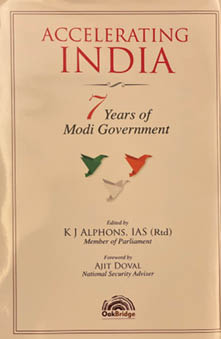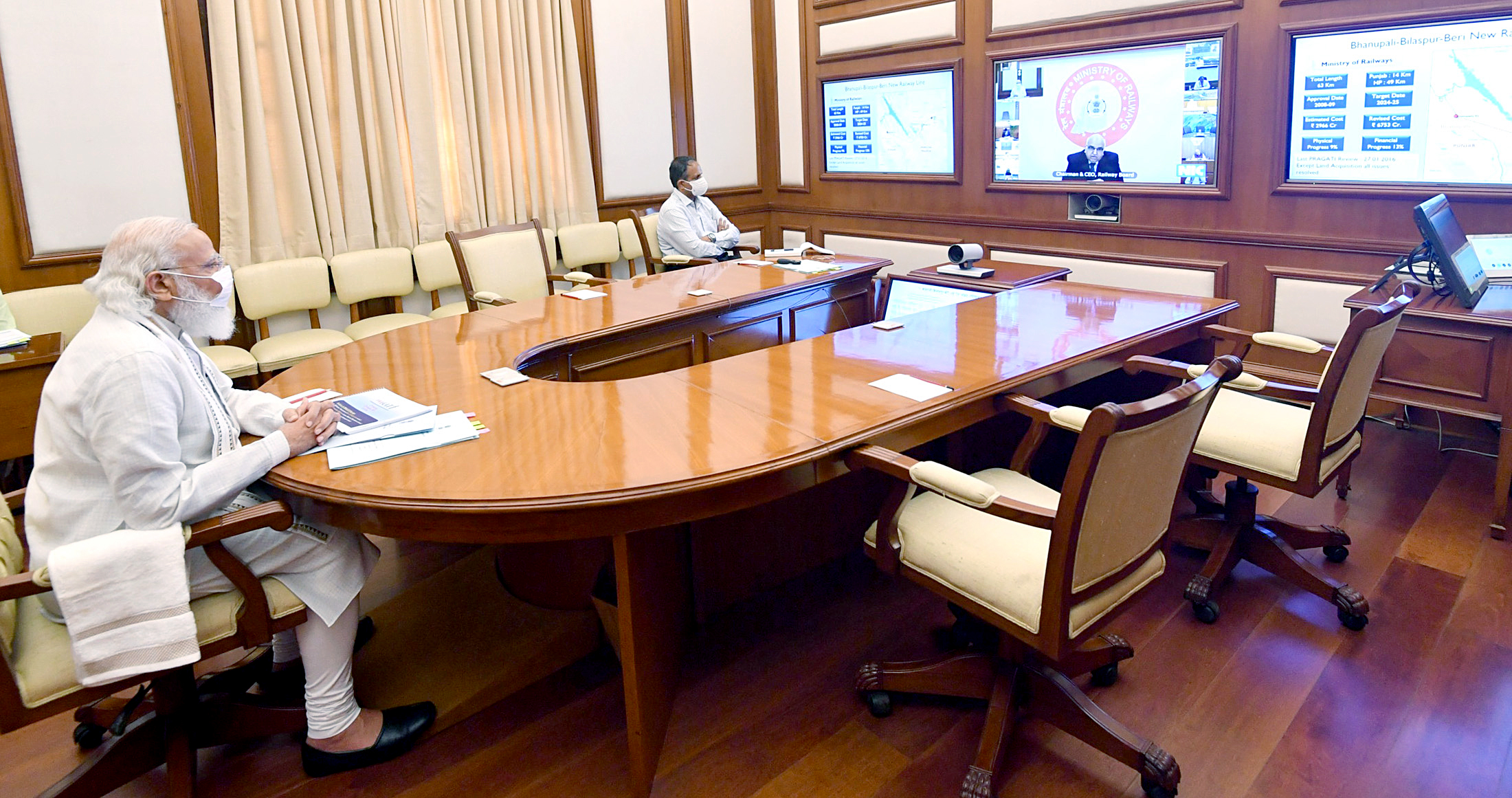The claim is that India has stayed the course in pursuing economic reforms through the years of lacklustre global economic growth, caused by weak global demand conditions, tight domestic financial conditions and weak or erratic monsoons, and above all, the pandemic.
Given that the latest book on the Modi government is edited by K.J. Alphons, a former Minister and a BJP Member of Parliament and carries a foreword by Ajit Doval, National Security Adviser, no one should expect it to be an objective account of seven years of Modi government. The authors of the chapters are also those who have either been part of the government at one time or another or its advisers. But the purpose of the book is entirely honourable as it presents facts as they are known to those who shaped or implemented the policies based on the vision of PM Narendra Modi, who himself has endorsed the contents of the book in a tweet. They have also had the rare benefit of interaction with the Prime Minister. This is next only to getting it from the horse’s mouth.

Edited by K.J. Alphons
Pubisher: OakBridge Publishing
No one better than Amitabh Kant could have given a more comprehensive overview with his perch in the Niti Aayog with his finger in every pie. In effect, Niti Aayog has become more visible and influential than the Planning Commission and Kant, being a hands-on administrator, has the pulse of the people to know the success and otherwise of the innumerable yojanas which have emerged from the PM’s “revolutionary vision”. Interestingly, he considers the Swachh Bharat Mission and the Aspirational District Program the most important among them, as they resulted in a scientifically executed behavioural change even if India is not entirely open defecation-free as yet. The National Education Policy has been rightly rated as a significant achievement as the entire education system is being refurbished. I was glad to see some of what we tried to do during the Oommen Chandy government in higher education. The implementation of the policy will be an uphill task, but a beginning has been made. Kant mentions many other futuristic measures in technology, reshaping the bureaucracy, combating Covid-19 and others, but the most important point he makes is that empowerment has been at the core of the PM’s agenda and a brave beginning has been made, even though his assertion that PM has “delivered on all fronts with passion and speed” may be called into question.
Having followed PM Narendra Modi’s foreign policy closely and written a book on his first term, “Modiplomacy”, I can vouch that Shakti Sinha’s account of foreign policy is fairly objective, though he has glossed over the criticism that PM Modi personalized foreign policy and did not give credit to Pandit Nehru and others for laying the foundations, which enabled him to build on them. Continuity and change by not hesitating to overcome the hesitations of the past where necessary were the hallmarks of the foreign policy of the last seven years. Having seen Modi in action on the Capitol Hill and in the World Bank, seeking to punish Pakistan economically for Kargil, I was aware that he had a penchant for international affairs as he demonstrated as soon as he became PM. The bold initiatives he took brought India to the central stage. His best moment was in 2016 when he declared a new symphony in India-US relations on account of his extraordinary equation with President Barack Obama. But more importantly, he turned around the setbacks on account of the unpredictability and strange ways of President Trump to India’s advantage.
Sinha reminds us of the many travels and meetings of the PM and the way he charmed many nationalities, particularly those of Indian origin. He broke out of the doctrinaire approach of the past and reconciled the seemingly intractable differences with other nations. He mentions the links with the Quad and SCO, trilateral dialogue with Japan and the US on one hand and Russia and China on the other, close relations with Saudi Arabia, Israel and Iran. But the list of such examples could be longer.
PM Modi played a significant role in Paris on climate change, but the US came on board on an international climate change agreement in Copenhagen, when PM Manmohan Singh agreed to move away from the Rio consensus. Paris was only the formalization of Copenhagen. Similarly, speaking of the Nuclear Liability Act, it should be recalled that it was the opposition, which pressed it in Parliament during the UPA government and the solution to the issue through the insurance route did not work out as Sinha mentions. The nuclear trade with the US, envisaged in the India-US nuclear deal never materialized because of the Nuclear Liability Act. But his overall assessment that PM Modi’s foreign policy ensured continuity, but with a strong dose of change, so much so that the trajectory often moved to a higher plane, is fair.
The internal security and defence chapters describe how the structures in both the sectors have been strengthened not only according to the PM’s vision and plans, but also in response to specific situations which arose in seven years. It must have come as a great disappointment to him that right in the middle of the pandemic, China, whose leader he met many times, unleashed an incursion across the Line of Actual Control. The way the situation was handled with a mix of firmness and flexibility bears testimony to the success in both internal and defence policies. A former Home Secretary and a Defence Secretary have competently outlined the achievements.
The chapter on the economy is the centrepiece of the book. Bimal Julka and Anantha Nageswaran begin with a picture of an economy in a shambles as the macroeconomic backdrop that PM Modi inherited. They characterize demonetization as a sagacious and courageous decision of the PM. The objectives of demonetization were several, but it was mainly to curb the widespread use of black money. They concede that “judgment on epochal policy decisions cannot be rendered instantaneously or real-time.” But they make a tantalizing promise that unlike bank nationalization, “which turned out to be mixed to negative,” at the end of five decades, demonetization will be found positive during the same period. That is a promise that the entire nation will want to see fulfilled. They virtually say that the jury is still out on the benefits of demonetization. The claim is that India has stayed the course in pursuing economic reforms through the years of lacklustre global economic growth, caused by weak global demand conditions, tight domestic financial conditions and weak or erratic monsoons, and above all, the pandemic, which is dealt with in the next chapter.
The chapter on lessons learnt for policy making in Covid times by Sanjeev Sanyal traces the Indian response to the pandemic from the days when India was groping in the dark for lack of information or a strategy. The early lockdown was to get time to get the scientific picture right and to engage our scientists to shape a defence plan. By avoiding spending on a stimulus package, India conserved resources for the new technologies as they became available. By June 2021, the options became clearer and a targeted approach for intervention became necessary. The economic planners were in the same place as the health policy makers and even today there is no certainty about the possible extent of the disease or the economic recovery. Sanyal explains the problem with planning in an uncertain world. He quotes a Prussian General who said, “No plan survives the first contact with the enemy.”
As for the future, Sanyal offers sound advice: “Invest in surveillance rather than forecasting models. Finally respond quickly, firmly and flexibly. Use real time observation to get feedback and adjust to the evolving situation. With experience, one will be able to anticipate a few things—these should be promptly adjusted so that management and mind space is free to deal with the truly unpredictable.” He has not attributed any of the decisions on the pandemic to the PM.
Anand Bose’s essay on the Civil Services in India underlines the issues that arose in transforming a colonial service to make it serve the people. In actual fact, civil services still have many of the relics of the colonial era, with the additional scourge of corruption. He outlines PM Modi’s Mission KarmAayogi project, which seeks to reform the Civil Services under the supervision of the Prime Minister himself. “The KarmAayogi Mission is a step in the right direction, a step taken at the right time,” he asserts. But his comment that KarmAayogi is meant to equip the Indian civil service to explore the sound of silence, the inner world of administrative acumen is somewhat rhetorical. But his conclusion is that “Civil Servants have chosen to be pushed into the river laden by crocodiles. They have no way but to swim and reach the bank. KarmAayogi Mission empowers them to negotiate the turbulent river to reach the bank safely.” But the proof of the pudding is in the eating, he implies.
Governor Arif Mohammad Khan’s chapter on triple talaq is a virtual treatise on the historical and religious context of the phenomenon. He has taken pains to elaborate it for the readers to know how complex the issue was and how PM Modi quickly understood the whole issue in one sitting with him and acted expeditiously to enact a law “in a truly courageous, albeit risky move.”
Alphons is at his argumentative best in the short epilogue, in which he challenges the readers to debate the policies of the Modi government and the data provided. He encapsulates the major traits of the previous Prime Ministers and expresses his belief that PM Modi has initiated policy reforms and implemented them like never before, with a huge sense of purpose. He disputes the theory that PM Modi is pro-rich and right wing as his actions have always been for the poor, though he needs creation of wealth by the private sector. He ends with an exhortation to support elected governments at the centre and the states, irrespective of political or religious beliefs. to give people a dignified life.
s expected, the book unabashedly focuses on the positive aspects of the Modi government, skirting around many divisive issues. But it contains a wealth of information for those who seek to be well-informed before applauding or denigrating the government.
T.P. Sreenivasan (IFS 1967) is a former Ambassador of India and Governor for India of the IAEA.

